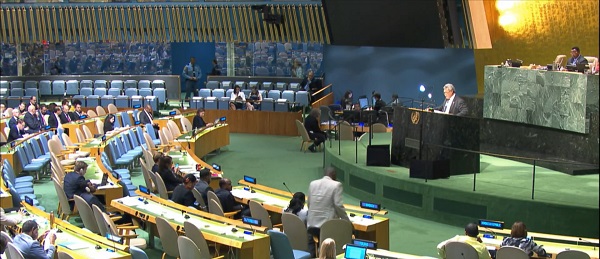Business
There’s a cost to bad recruiting practices

We all hear about the frustration job seekers feel when they submit their job application online and never hear another word. But how much does this damage your brand? Here is some really good advice from a contributor from Edmonton.
The cost of a bad experience – by Shane Calder
(Photo by Brooke Cagle on Unsplash)
“In 2015, Virgin Media received approximately 150,000 job applications, translating into 3,500 new hires. The company estimated that 27,000 (18%) of those applicants were also customers—and that poor candidate experiences led 7416 of those applicant customers to churn from Virgin Media.”
Bad experience costs you?
Virgin Media lost 6 million dollars in revenue as a result of their candidates experience.
(Photo by Robin Worrall on Unsplash)
How is it costing your company?
It’s simple. It’s negatively impacting your brand.
“Nearly 60% of Job Seekers have had a poor candidate experience & 72% talk about it.”
Candidates want to be contacted with progress of their application. 80% of applicants are discouraged to reapply if they received no feedback. Poor experience can be detrimental to your candidate search and your company’s online reputation. Candidates actually value knowing about the status of their application more than a polished website or a well-designed careers page.
Source: https://workplacetrends.com/candidate-experience-study/
Technology Woes 
(Photo by Adam Birkett on Unsplash)
Have you lost the personal touch?
Candidates who were unsuccessful in a job application doubt a person even reviewed their application. If 85% of the applicants who apply to a job posting doubt that it was ever reviewed by an actual person, imagine the negative impact on your brand and how you are viewed. Will this activity help attract talent?
Add the personal touch.
Augment your resources. Don’t remove your HR professionals from the conversation. Build a rapport with your candidates. Use emails, live chats and social media.
Source: https://www.thetalentboard.org/cande-awards/cande-research-reports/
Rejected offers
(Photo by Ian Tuck on Unsplash)
In the IBM white paper “The far reaching impact of candidate experience” it was discovered that if a candidate has a good experience there is a 54% chance they will accept an offer. If the experience was a disappointment only 39% would accept an offer of employment. Candidates with a positive experience are 2 times more likely to become a customer. The candidate experience is your company’s opportunity to build brand advocates even if no offer is given.
Source: https://www.ibm.com/downloads/cas/YMOARJJG
Social License To Operate

Photo by Nicole Honeywill on Unsplash
The candidate experience impacts your company and is an opportunity to showcase your company. Don’t miss out on the opportunity to improve the experience. The rewards of increased revenue, reduced costs, advocates and finding good talent are within your control.
Treat job candidates well, give them a great experience and you will be rewarded.
Shane Calder is Principal, 132 ENG Inc. He can be reached at [email protected]
132 ENG is an exclusive Engineering and Technical Services Company, providing placement and recruiting services. Discover our real results. 132Eng experts have proven expertise and depth of knowledge that is powerful. Let us make it easy, save you time and make you look amazing. It will be our secret.
Business
Trump confirms 35% tariff on Canada, warns more could come

Quick Hit:
President Trump on Thursday confirmed a sweeping new 35% tariff on Canadian imports starting August 1, citing Canada’s failure to curb fentanyl trafficking and retaliatory trade actions.
Key Details:
- In a letter to Canadian Prime Minister Mark Carney, Trump said the new 35% levy is in response to Canada’s “financial retaliation” and its inability to stop fentanyl from reaching the U.S.
- Trump emphasized that Canadian businesses that relocate manufacturing to the U.S. will be exempt and promised expedited approvals for such moves.
- The administration has already notified 23 countries of impending tariffs following the expiration of a 90-day negotiation window under Trump’s “Liberation Day” trade policy.
Diving Deeper:
President Trump escalated his tariff strategy on Thursday, formally announcing a 35% duty on all Canadian imports effective August 1. The move follows what Trump described as a breakdown in trade cooperation and a failure by Canada to address its role in the U.S. fentanyl crisis.
“It is a Great Honor for me to send you this letter in that it demonstrates the strength and commitment of our Trading Relationship,” Trump wrote to Prime Minister Mark Carney. He added that the tariff response comes after Canada “financially retaliated” against the U.S. rather than working to resolve the flow of fentanyl across the northern border.
Trump’s letter made clear the tariff will apply broadly, separate from any existing sector-specific levies, and included a warning that “goods transshipped to evade this higher Tariff will be subject to that higher Tariff.” The president also hinted that further retaliation from Canada could push rates even higher.
However, Trump left the door open for possible revisions. “If Canada works with me to stop the flow of Fentanyl, we will, perhaps, consider an adjustment to this letter,” he said, adding that tariffs “may be modified, upward or downward, depending on our relationship.”
Canadian companies that move operations to the U.S. would be exempt, Trump said, noting his administration “will do everything possible to get approvals quickly, professionally, and routinely — In other words, in a matter of weeks.”
The U.S. traded over $762 billion in goods with Canada in 2024, with a trade deficit of $63.3 billion, a figure Trump called a “major threat” to both the economy and national security.
Speaking with NBC News on Thursday, Trump suggested even broader tariff hikes are coming, floating the idea of a 15% or 20% blanket rate on all imports. “We’re just going to say all of the remaining countries are going to pay,” he told Meet the Press moderator Kristen Welker, adding that “the tariffs have been very well-received” and noting that the stock market had hit new highs that day.
The Canadian announcement is part of a broader global tariff rollout. In recent days, Trump has notified at least 23 countries of new levies and revealed a separate 50% tariff on copper imports.
“Not everybody has to get a letter,” Trump said when asked if other leaders would be formally notified. “You know that. We’re just setting our tariffs.”
Business
Trump slaps Brazil with tariffs over social media censorship

From LifeSiteNews
By Dan Frieth
In his letter dated July 9, 2025, addressed to President Luiz Inácio Lula da Silva, Trump ties new U.S. trade measures directly to Brazilian censorship.
U.S. President Donald Trump has launched a fierce rebuke of Brazil’s moves to silence American-run social media platforms, particularly Rumble and X.
In his letter dated July 9, 2025, addressed to President Luiz Inácio Lula da Silva, Trump ties new U.S. trade measures directly to Brazilian censorship.
He calls attention to “SECRET and UNLAWFUL Censorship Orders to U.S. Social Media platforms,” pointing out that Brazil’s Supreme Court has been “threatening them with Millions of Dollars in Fines and Eviction from the Brazilian Social Media market.”


Trump warns that these actions are “due in part to Brazil’s insidious attacks on Free Elections, and the fundamental Free Speech Rights of Americans,” and states: “starting on August 1, 2025, we will charge Brazil a Tariff of 50% on any and all Brazilian products sent into the United States, separate from all Sectoral Tariffs.” He also adds that “Goods transshipped to evade this 50% Tariff will be subject to that higher Tariff.”
Brazil’s crackdown has targeted Rumble after it refused to comply with orders to block the account of Allan dos Santos, a Brazilian streamer living in the United States.
On February 21, 2025, Justice Alexandre de Moraes ordered Rumble’s suspension for non‑compliance, saying it failed “to comply with court orders.”
Earlier, from August to October 2024, Moraes had similarly ordered a nationwide block on X.
The court directed ISPs to suspend access and imposed fines after the platform refused to designate a legal representative and remove certain accounts.
Elon Musk responded: “Free speech is the bedrock of democracy and an unelected pseudo‑judge in Brazil is destroying it for political purposes.”
By linking censorship actions, particularly those targeting Rumble and X, to U.S. trade policy, Trump’s letter asserts that Brazil’s judiciary has moved into the arena of foreign policy and economic consequences.
The tariffs, he makes clear, are meant, at least in part, as a response to Brazil’s suppression of American free speech.
Trump’s decision to impose tariffs on Brazil for censoring American platforms may also serve as a clear signal to the European Union, which is advancing similar regulatory efforts under the guise of “disinformation” and “online safety.”
With the EU’s Digital Services Act and proposed “hate speech” legislation expanding government authority over content moderation, American companies face mounting pressure to comply with vague and sweeping takedown demands.
By framing censorship as a violation of U.S. free speech rights and linking it to trade consequences, Trump is effectively warning that any foreign attempt to suppress American voices or platforms could trigger similar economic retaliation.
Reprinted with permission from Reclaim The Net.
-

 Also Interesting2 days ago
Also Interesting2 days ago9 Things You Should Know About PK/PD in Drug Research
-

 Business2 days ago
Business2 days agoCannabis Legalization Is Starting to Look Like a Really Dumb Idea
-

 Media2 days ago
Media2 days agoCBC journalist quits, accuses outlet of anti-Conservative bias and censorship
-

 Bruce Dowbiggin2 days ago
Bruce Dowbiggin2 days agoThe Covid 19 Disaster: When Do We Get The Apologies?
-

 Business2 days ago
Business2 days agoCarney government should recognize that private sector drives Canada’s economy
-

 Alberta2 days ago
Alberta2 days agoFourteen regional advisory councils will shape health care planning and delivery in Alberta
-

 Alberta2 days ago
Alberta2 days agoAlberta school boards required to meet new standards for school library materials with regard to sexual content
-

 Business1 day ago
Business1 day agoUN’s ‘Plastics Treaty’ Sports A Junk Science Wrapper








